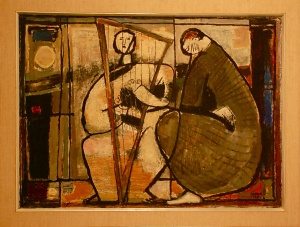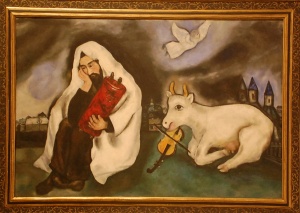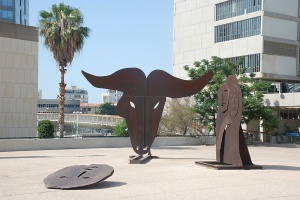Tanach at the Tel Aviv Museum
As an artist when I visit a museum I relish the opportunity to soak up a gamut of aesthetic experiences, the wonderful array of visual and intellectual stimulation that characterizes looking at any kind of art. Simultaneously I am constantly on the look-out for works of specifically Jewish interest. And of course always at the top of my surveys are those artworks that one way or the other deal with the Bible.
After all the Tanach is what I have painted for over thirty years and what I consider the most important subject an artist can tackle. Because of my personal beliefs and its extensive record in Western art, Tanach to me is the Subject of Subjects. It provides the artist with a limitless variety of human narratives, social interaction and divine machinations to explore the depths of the human condition. For a complex examination of the fabric of human existence Tanach has no equal. It speaks my language.
On a recent stroll through the Tel Aviv Museum of Art I encountered three diverse works that utilize Tanach in very different ways, each revealing both the attitude of the artist and an equally fruitful potential use of Tanach in artistic expression.

In a major retrospective of the Israeli artist, Avraham Naton (1906-1959) an intriguing work David and Saul (1951) stood out as the only biblical work of his shown. In this survey of Naton’s work we see that he started with figurative representation and slowly moved towards more and more abstraction, imposing an order on the visual world with a clear geometry of his last works. He was a member of the New Horizons group that effectively legitimized and supported a new abstract art in Israel (echoing the New York School) from the early 1950’s until the mid-1960’s. Within this context Naton’s biblical work seems quite singular. The Bible was hardly on the avant-garde’s ‘A’ List of Subjects.
Two spare figures dominate the rectangular image; one on the right dark and crouching in the foreground is certainly Saul deep in thought. The center figure is David playing the big triangular harp, dressed in white and seated facing us. The figures are depicted with a minimum of detail instead depending on a bold expressive outline whose abstract nature allows the two of them to effectively overlap and link in some fundamental way. David’s expression is barely aware of the anguish he is causing the ill-fated Saul.
Because of the tight geometry that composes the picture there is an overwhelming claustrophobia that correctly characterizes the tragic relationship between Saul and David. In this painting Naton has probably expressed a good deal of the tension he was personally undergoing in his aesthetic search from figuration to abstraction even as he brilliantly depicted a fundamental aspect of the David/Saul relationship. For Naton his brief foray into biblical art was particularly fruitful. I think this work is one of the strongest paintings in his retrospective.

In contrast Marc Chagall’s Solitude (1933), while a well-known painting, is at first glance not immediately compelling. The three main figures are stiffly arranged, a seated rabbi, a sweet faced cow to the right and a diminutive white angel above them both. There is an odd atmosphere of melancholy mitigated by the funny cow. At first glance the solitude experienced by the rabbi holding the red Torah is the only obvious narrative element.
Scholar Mira Friedman maintains that this figure is from Jeremiah referring to Lamentations 1:1; “Alas, the city sits solitary…” Additionally she sees the cow as referring to the midrash in Eichah Rabbah 1:51 relating that when a certain cow bellowed it signaled the destruction of the Temple and when it bellowed again it heralded the birth of the messiah whose name was “Comforter.” Which bovine note are we hearing?
Chagall produced this painting at an auspicious period in his life and work. He had begun working on a monumental project in 1931, a series of etchings promoted by the famous publisher Ambrose Vollard simply called “The Bible.” Increasingly consumed by the biblical narratives he had just returned from a tour of Palestine, inspired by the vibrant new settlements and young Jewish artist’s community. But deeply troubling events loomed on the horizon; the Nazi rise to power in Germany threatened Jews everywhere and immediately resulted in his paintings being publically burned in Mannheim, Germany.
Now the diverse elements begin to come together; the cow operates as both herald of doom and hope: one symbol that carries two meanings. The violin playing cow in yet another aspect, also seen in a drawing in Bella Chagall’s Burning Lights, figures as a representation of Tisha b’Av. On this day of mourning art (music) and hope are silenced along with the comfort of the Torah itself as the world smolders under dark foreboding clouds. The small white angel unsuccessfully attempts to flee what we now know will become a holocaust. Chagall and his family would be safe in Paris and then in the south of France until he fled to the United States in June 1941. The symbolic world he depicted in “Solitude” was tragically not so fortunate. Chagall’s work is deeply personal even as he reacts passionately to the world around him. It is all in the details.

As I leave the Tel Aviv Museum of Art Menashe Kadishman’s monumental steel sculpture Sacrifice of Isaac (1987) dominates the plaza. It is brutal and riveting. Kadishman’s work has intrigued me for years, especially this subject but also his haunting Shalechet (Fallen Leaves) notably installed as a Holocaust memorial in the Jewish Museum Berlin (2001).
Problems arise. The artist states “Neither do I consider the story of the sacrifice of Isaac as signifying a divine command or decree of God. For me it symbolizes the fear of the individual to defy the dictates of society and its conventions.” Not surprisingly he understands that a man who sacrifices his son, sacrifices himself, i.e. his entire future. This sculpture was executed in the shadow of the war in Lebanon and his own son’s induction into the army. Upon closer inspection the sculpture represents the head of the dead Isaac on the ground, two grieving women (or parents) stand to the right and the head of the ram triumphant over the entire scene. But how does it add up?
Its complicated. It seems that the Tel Aviv born Kadishman worked as a shepherd on a kibbutz in his youth and in fact has used sheep and rams as a recurring motif in his work throughout his career. Additionally in 1973 he and his son modeled for George Segal’s Isaac’s Sacrifice. That would explain how he has been deeply obsessed with the Isaac story since the early 1980’s producing many drawings, paintings and sculptures. But now back to this sculpture.
He has done a certain violence to the narrative, excluding God, Abraham and the angel and inserting two non-textual grieving figures. The notion that the sacrifice of Isaac is somehow the proto-typical anti-war narrative, reconfigured into the debate over the morality of fathers sending their sons to war seems far fetched at best. Its complicated.
Lets ignore what the artist says and just look at the sculpture. Our narrative is reduced down to the barest elements: the dead Isaac, the ram, and grieving women or parents, each supported by our tradition. First of all we have a midrashic tradition that Isaac did in fact die, was transported to heaven and then resurrected. Commentators say that the second brocha of the amidah reflects this narrative indicating that God indeed resurrected Isaac. The grieving mothers, as identified in other Kadishman works, can be easily seen as Sarah and Rebecca, a future wife who may never know her husband and of course, Sarah. Surely the midrashim are filled with explanations of Sarah’s death caused by her belief that Isaac had been slaughtered. But what about the striking ram?
Here is where Kadishman veers off course. The ram can be triumphant only in this midrashic version of the story. But of course to make the death of Isaac the end of the story obliterates the rest of Jewish history. It distorts the narrative to become a mere tool for personal guilt and anger. Similarly depicting the ram as a triumphant and violent immoral power while simultaneously removing God as the prime mover in this narrative avoids the really difficult issues the Sacrifice of Isaac continues to pose about God’s role and responsibility.
Kadishman’s Sacrifice of Isaac is a powerful and brutal indictment of war, the forces of violence and the tragic death of innocents. Unfortunately it fails to take the biblical narrative seriously enough and place the protest where it belongs at heaven’s gate.
I would like to acknowledge the following sources for quotations and background information: Mira Friedman, “Marc Chagall’s portrayal of the prophet Jeremiah,” 1984; Christine Tacke, “The Sacrifice of Isaac” (www.kadishman.com); Ziva Amishai-Maisels, “Jewish Art,” Abrams 1997.
Tel Aviv Museum of Art
27 Shaul Hamelech Blvd.
Tel Aviv 64329, Israel